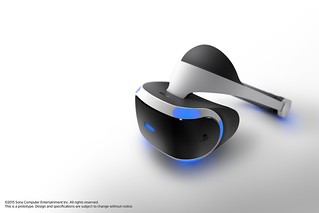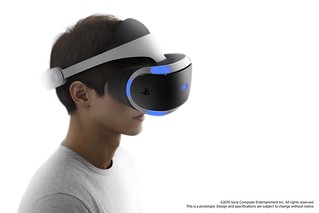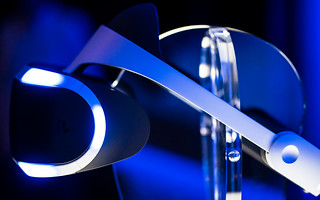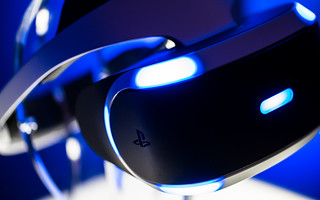Sid Shuman
I’ve decided that describing virtual reality to someone who’s never tried it is basically impossible. Like tasting or smelling or seeing, VR is a sensory experience that you have to try for yourself to truly understand. Words can’t do it justice.
Nonetheless, Justin and I will do our best. Fresh off our positive test drive of last year’s original prototype, we were curious how much Project Morpheus’s upgraded specs have enhanced the overall VR experience, most notably that illusion of “presence” — the fragile feeling that you’re actually inhabiting the game’s world.
Read on for Justin’s thoughts. But based on what I experienced, Project Morpheus has indeed come a long, long way since last March. For starters, the headset feels far lighter and much more comfortable. The screen can slide forward a few inches, which makes makes taking it on and off a much simpler affair.
“The new display makes a world of difference.”
Then there’s the display, which has seen a hefty upgrade from last year’s LCD to an OLED 1920 X RGB X 1080 specification that boasts richer colors and silky smoothness thanks to the new 120hz refresh rate. There’s no doubt about it: The new display makes a world of difference.
There are myriad other enhancements. Nine LEDs now adorn the front and sides of Project Morpheus, which will allow PS Camera to track in 360 degrees. And latency, that eternal enemy of VR engineers, has been reduced to less than 18 milliseconds — a key technical achievement that promises to make the player’s movements more responsive and the experience more immersive.
What none of these technical specs explain is how immersive Project Morpheus really is. It’s groundbreaking. I tried out two demos, “Magic Controller” and “Bedroom Robots,” both of which starred the cute little Asobi robots from PS4’s Playroom app.
“Magic Controller” was a great introduction to the basics of VR. As I peered down at my DualShock 4, I saw a 3D cartoon simulacrum accurately overlaid over the form of my actual DualShock 4, keeping up a perfect illusion as I rotated the controller in my (real) hands. This was fascinating enough, but then the “magic” DualShock 4 transformed into a music player, and then a working flashlight, before my eyes.
“It’s impossible to explain.”
This demo might sound like kid’s stuff, but I was totally engrossed. I clicked the touchpad to deploy a small army of Asobi robots, who began dancing frantically while I waved my DualShock 4 flashlight’s beam over them. Thanks to the headset’s realistic depth perception, I felt like I was there, inhabiting that smoky dance floor with them. It was an impressive start.
The second demo, “Bedroom Robots,” took a different approach. In this voyeuristic VR demo, I peered into a dollhouse populated with tiny robots. Leaning in closer to get a better look, I watched them ride exercise bikes, throw frisbees, and play ping-pong. Project Morpheus kept up perfectly with all of my real-life moments, letting me change my viewing angle as naturally as in real life.
As I studied the tiny figures, a shiver traveled up my spine. The animations were charming enough, but if I had viewed this scene on a TV screen I wouldn’t have given it a second glance. Seen through Project Morpheus, the scene took on a weight and a gravity I haven’t experienced outside of, well, real life. Again, it’s impossible to explain. You really do have to try it.
The technical stuff is way beyond me. But I’m hugely hopeful that Project Morpheus will empower completely new approaches to “game” design. Imagine a VR murder mystery that puts you at the center of a dinner party, or a stroll through an alien garden where you can stop to smell the (flesh-eating) roses. Played on a 2D TV screen, these experiences might look neat, but you’d be done in minutes. Experienced through Project Morpheus, they have the potential to be truly memorable and powerful.
My body is ready.
Justin Massongill
My Project Morpheus experience involved a cage, some jellyfish, an agitated shark, an increased heart rate and a genuine sense of terror.
First things first: strapping the newest prototype onto my noggin was a trivial affair, requiring minimal adjustments to find a comfortable fit (which left space for my glasses without sacrificing precious immersion).
“It left space for my glasses without sacrificing immersion.”
A refresh of last year’s demo, “The Deep” showcases just how convincingly PS4’s prototype VR headset can persuade the human brain that you’re somewhere you’re not. Project Morpheus’ new enhancements coalesce to drastically elevate the demo’s immersiveness.
As the demo began, I found myself standing in a cage maybe 20 feet under water. When I looked straight up I could see the cable suspending me, leading back up to a small boat on the surface. Schools of fish swam by, and bubbles floated through the water, sometimes just in front of my face — an unexpected “wow” moment each time it happened.
I descended further down through different scenes, including a particularly gorgeous area lit only by passing jellyfish, leading to the meat of the demo: a tense standoff with a shark who had a hankerin’ for some tasty human flesh.
After circling my cage a few times, the creature lunged at me. Thankfully my steadfast vessel fended off my would-be killer. The shark latched on to one of the cage’s light fixtures, jerking and thrashing it loose and tossing it to the ocean floor. The cage shook with each pull, which — get this — my brain interpreted as actual movement. Embarrassingly, I involuntarily tried to compensate for this by moving my real-life legs. I had to make a concerted effort to remind myself that I wasn’t actually hundreds of feet underwater, being attacked by a highly evolved aquatic predator.
“One time, I caught myself actually taking a step back.”
After a couple more circles around my beaten and battered cage, the shark came at me again. Then again. Each time, he would barely miss and nudge the cage to the side, or he would tear into another part of the cage and rip it off. Eventually, the entire front panel of the cage was gone, leaving nothing but fear between me and my impending end. I stood, alone and vulnerable, inside three fourths of a cage, watching as the animal circled, eyeing me — toying with me. He made a run for me a couple more times, and one time I caught myself actually taking a step back. Again, involuntary.
At this point, my palms were sweaty. My heart was beating just a bit faster than normal. I felt genuinely uncomfortable even though I knew none of this was real. As far as my brain was concerned, it was real. I was there. I was, in some small part of my mind, mildly scared for my life.
This is the most exciting proposition of Project Morpheus, and of virtual reality as a concept. If someone who’s closely followed and scrutinized this new technology can still be awed by it, imagine how inspiring and transformative it could be for others! One of our most impossible science fiction fantasies is here, it’s real, and it’s exactly as unbelievable as we had hoped it would be.
Exclusive Car Review at www.automoview.com



